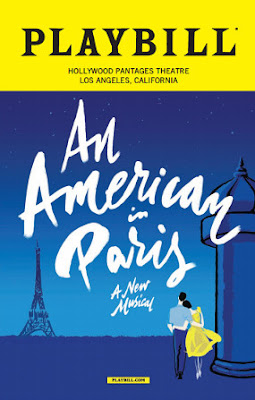
Given its (deserved) status as a classic of the movie musical format, it's a bit shocking that it's taken more than a half-century wait for there to be a major live theatrical adaptation of An American in Paris. For some ardent, purist fans of the landmark 1951 Gene Kelly/Vincente Minnelli/George and Ira Gershwin collaboration, it would not be unfair to say that the wait continues, for book writer Craig Lucas and director/choreographer Christopher Wheeldon take a very free hand in fashioning the film for the stage. But however many liberties they and the rest of the creative team take with the source material, they just as accurately capture the boundary-breaking creative essence of the film while being its own distinct, imaginative, and satisfying entertainment on its own terms.
On the stage as it was on screen, the show's primary narrative focus is on the love that blossoms between the titular American in Paris, artist Jerry (Garen Scribner) and young French woman Lise (Sara Esty). Also present are Milo (Emily Ferranti), a rich woman who takes a shine to Jerry; and Jerry's buddies Adam (Etai Benson), a songwriter; and Henri (Nick Spangler), a singer. The film's love triangle between Jerry, Lise, and Henri becomes a quadrangle here, with a now-Lise-besotted Adam more than just a comic sidekick and more firmly entrenched in the main action. But from those basic elements from Alan Jay Lerner's screenplay Lucas builds his own thing, which is clear right after the curtain rises, filling out Jerry's backstory with a prologue that also moves this story's setting into the more immediate WWII aftermath, detailing how this American soldier came to take residence in Paris.
That opening sequence also boldly announces Wheeldon's overriding approach to the entire production, which is to have words and even the Gershwins' music come distinctly secondary to the expression and narrative propulsion of dance. While that may not come as a surprise given that the original film is a vehicle for iconic screen hoofer Kelly, Wheeldon takes less inspiration from the well-known screen persona of the movie's beloved star than its rightfully legendary 17-minute, all-dance fantasy sequence climax, where Minnelli bravely--and spectacularly--adopted the old school stage convention of an extended "ballet" interlude for the cinema. Wheeldon's 11-o'clock stage analogue to that sequence is, predictably, the highlight of his show, but with his long, illustrious background in classical ballet turning the figurative "ballet" into a literal one that showcase the remarkable control, coordination, and fluid grace of Scribner and especially Esty, whose Lise is here is not just a simple shopgirl but a ballerina. But that's just the tip of the iceberg as far as how Wheeldon makes his true inspiration come alive on his stage. The simple, sometimes schematic paintings that serve as backdrops for portions of the movie's big ballet largely informs Bob Crowley's fairly minimalist but effective scenic design, with projections and animations of paintings and sketches serving as an ongoing manifestation and connection to Jerry's artistic pursuits. Most prominently and boldly of all, however, is how Wheeldon injects and intertwines ballet into the proceedings even when Lise's character is neither rehearsing nor performing, often using ballet interludes in a way akin to montage is employed in cinema, creatively creating an effect that merges movie and theater technique into something both practical and highly imaginative.
If these descriptions make this An American in Paris sound like it's merely inspired by, rather than more closely adapts, its filmic namesake, this is only the half of it. The emphasis on ballet means only a token nod to Gene Kelly's famous tap dancing skills, and even then the big tap number is centered around the Henri character, with the Kelly-originated Jerry nowhere to be found in the scene. Perhaps even more offensive to purists is that only five of the ten Gershwin compositions in the film are used here, not including what is arguably the film's central love theme, "Love Is Here to Stay." While there is a valid reasoning behind the differences in the song listing--the original film is, after all, a jukebox musical of pre-existing Gershwin songs, so Wheeldon and Lucas used others as they saw fit for their vision--not having the Jerry character do any tap dancing at all does indeed feel like a (bad pun intended) misstep.
But that's only one in a lovely production that gets it right where it needs to be: in crafting an irresistible musical, magical tribute to the swooningly romantic spell of the City of Lights. As much credit for that goes to Wheeldon, his vision would not have been fulfilled were it not for the truly multi-talented cast, most of whom must dance, sing, act, and emote--often all at once--with equal dexterity and conviction. They--especially the combustible couple of of Scribner and Esty--are what turn Wheeldon's radical concept into an involving and fully realized piece of theatrical art.
An American in Paris is now playing at the Pantages Theatre in Hollywood in a limited engagement through Sunday, April 9; it the returns to the Southern California area at the Segerstrom Center for the Arts in Costa Mesa on Tuesday, April 25 through Sunday, May 7.
Buy the An American in Paris Original Broadway Cast album CD here.Buy the An American in Paris movie Blu-ray here.
Buy the An American in Paris movie DVD here.
Buy the An American in Paris movie soundtrack CD here.
(Special thanks to Hollywood Pantages Theatre)
The Movie Report wants to attend and cover all your live stage productions! Please send any and all invitations to this address. Thanks!





